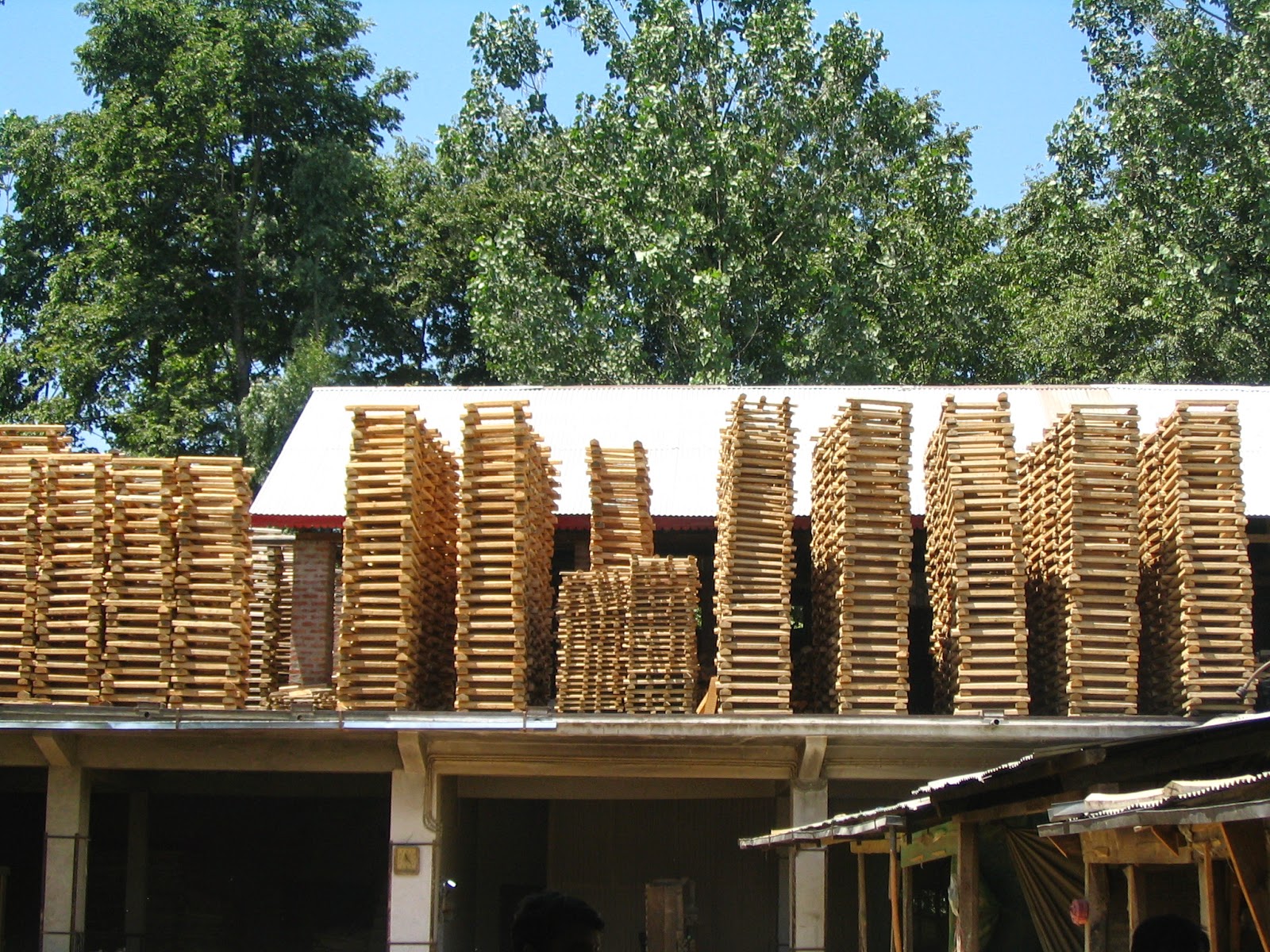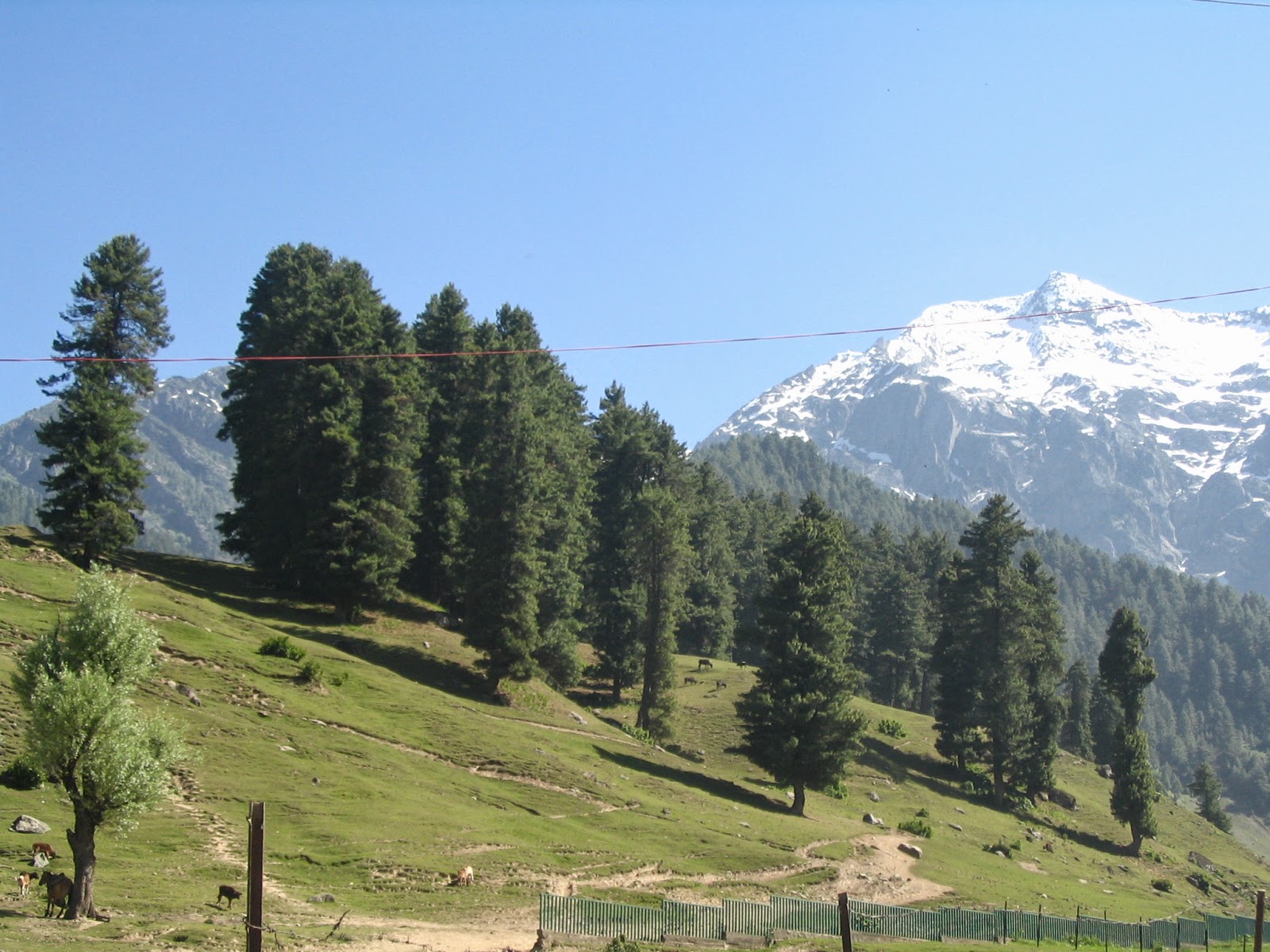Our first connect with Kashmir has been through Hindi films. The land
has provided a stunning backdrop to numerous film songs. We grew up
looking at those wonderful landscapes, which seemed tucked away in some
faraway fantasy land. That was then. It doesn't seem to be faraway now.
Looking at the snow-capped mountains from the window of my aircraft, I
sense a wave of exhilaration sweeping through me. Within minutes, we
touch down at Srinagar.

It is a small, very basic airport. Outside, the sun is shining brightly
and it is quite warm. We are greeted by our escorts and are soon on our
way to the houseboat in Nagin Lake, where we are to spend the first
night. But for some mountains in the distance, Srinagar looks like
any other town, with shops lining the road on both sides. It did feel special a couple of times when we passed by some water bodies with boats bobbing up and down in them. After a
longish ride, it is time to get down. A little walk and we arrive at a
lake where dozens of shikaras are waiting to take us to our houseboats. Our luggage efficiently loaded onto the shikaras, we set off happily, taking in the picturesque landscape. We are in Kashmir, at last!

The shikara glides gently on the calm waters of the blue lake. At the
other end are moored several houseboats, their wooden bodies looking
bright in the afternoon sun. Each houseboat is a spacious three-bedroom
house, complete with a lovely dining room, a plush living room, a deck
or balcony and a terrace. I am sharing my houseboat with a friendly
family from Mumbai. After depositing our bags in our rooms, all of us
come out to the deck to enjoy the fantastic view. The waters of the lake
look pristine, although at places, there are carpets of weeds on the
surface. And there are some lotus patches too. Photographers, masseurs,
people selling shawls and embroidered dress materials float by in
shikaras looking for prospective customers. Otherwise it is a tranquil
afternoon, and the ambience picture perfect with mountains lining the
serene lake at the far end. We just sit there and soak in the
atmosphere.

We get up only when it is time to go to the common area, close to the
point where we alighted from our shikaras, for an introductory session
with other members of our group over tea. It is a nice assembly, with
people belonging to different age groups. Introductions done, we walk
over to a nearby place selling colourful papier mache products. There
are bells, boxes, little shikaras, vases, bangles, key rings and several
other things that tourists like to pick up as souvenirs. People in my group start
buying things for friends and family back home. I like everything, but
am happy to just take pictures. This is only the first day, I tell
myself. We get back to the houseboat just in time for dinner. Our
leaders brief us about the next day's itinerary. We return to our rooms
soon because we have to check out early and leave for Pahalgam at 6:45 in the morning.
The room is comfortable. The bedspreads and curtains are adorned with
typical Kashmiri embroidery. The intricately designed wooden
ceiling--khatambandh--adds authenticity to the ethnic Kashmiri setting.
It is a quiet night outside. The houseboat attendant Irshad, a youth
from a nearby village, promises hot water in the bathroom at five in the
morning. I fall asleep in no time,as I had woken up at an unearthly
hour to catch my flight that morning.
---
Irshad keeps his word. Feeling fresh and rejuvenated after a nice hot
bath, I walk to the breakfast area. Our luggage is being assembled in
one corner. After a quick breakfast, we get into a largish boat to go
across the lake and board the two buses that will take us to Pahalgam,
95 kilometres away. All of us are excited to be in Kashmir and are
looking forward to enjoying the scenic beauty of its countryside.
We stop by at a shop selling dry fruits and spices in Lethpora, Pampore
in Pulwama district. This region is well-known for its saffron fields.
In fact, the back door of the shop opens into a huge saffron field.
Unfortunately, this is not the season, and the field is bare. "Come in
September if you want to see the flowers!", says the friendly chap who
is showing us around. He tells us that in season, the field is covered
with violet flowers. They grow on plants that stand no taller than eight
to 12 inches. Each flower has three red stigmas that are plucked and
dried carefully. This is the prized saffron that is used as an exotic
spice in various dishes. Since this is very expensive, some enterprising
people come up with fake saffron. Our man gives us tips on how to
tell the fake stuff from the real one. "One end of the strand must be
broader than the other end. If you put a strand in your
mouth, it should taste bitter. And if you put some strands in water, the
water should turn yellow, but the strands should retain their original
colour, no matter how long they stay in water." Armed with this
knowledge, we are now ready to take on the spurious saffron dealers!
My companions throng the counters to get their fill of spices and
dry fruits. I am mostly happy to walk around, take pictures and relish
the hot kahwa available just outside the shop.
Our next stop is the ancient Avantiswami Temple, a Vaishnava temple built somewhere between 855 and 883 AD. It is also in Pulwama district, located about 30 kilometres from Srinagar on the banks of the lovely river Jhelum.Our knowledgeable guide draws our attention towards the various carvings in stone and explains their significance to us. The appeal of the temple is enhanced by its surroundings-- colourful rose shrubs, stately Chinar trees and mountains in the distance. This location featured in the songs from the well-known 1975 film "Aandhi". Fortified after a snack and tea break, we move on.

After a while, we see workshops/shops making and selling
cricket bats lining both sides of the road. Hundreds of bats are piled
in a criss-cross fashion and left on the roofs of the shops to dry. We
stop by at a prominent shop. The affable Mr. Mushtaq greets us with a
smile. He is dressed smartly in a black pathan suit and a white skull
cap. He tells us about the abundance of willow trees in Kashmir and why
their wood is best suited to make cricket bats. "It is very tough,
shock-resistant and it doesn't get splintered on being hit with a ball
at high speed. This wood is found only in England and Kashmir", he says.
He is very witty, articulate and ends his sermon with a puzzle that
sets all of us thinking. When we fail to come up with an answer, he
reveals it with a naughty smile. It WAS quite silly and we disperse,
thanking him amidst loud guffaws. Some go to the workshop, and some to
the shop to buy an authentic Kashmiri willow bat.

We resume our journey towards Pahalgam. The road is slightly uphill and
the vegetation changes. All of us are thrilled to find a gurgling river
running parallel to the road. Everybody rushes to the windows of the bus
with their cameras. It is the river Lidder. It runs alongside the road
all the way up to Pahalgam. In fact, our hotel offers a breathtaking
view of the river against the dark mountains in the background.
We check into the hotel and have lunch. After some rest, we are out to
explore the lovely hill town. There is a nice park by the river. Some of
us venture to touch the gushing water...it is ice cold! It is nice to
see many local families enjoying a picnic in the park. God has blessed
this land not only with natural beauty, but also with beautiful people.
Men look handsome with their sharp noses and trimmed beards, while women look
pretty with their kohl-rimmed eyes and stunning faces. And their
complexion? Flawless rosy pink! How can so much beauty be concentrated
in one place, I wonder.
We are accosted by the ever-present salesmen several times, trying to
sell us their wares--shawls, stoles and dress material. The competition
is severe and each one tries to outdo the others when it comes to
bringing down the prices. "We earn only in six months and sit at home
for the other six months", they plead. It requires a lot of
determination to shake them off!
Back to the hotel for dinner after a very enjoyable outing in the park.
Dinnertime is the briefing time for next day's programme. It is Aru
Valley and Chandanwari tomorrow.
---
Big buses are not allowed in this region so we split into groups of six
and board the vans that have been arranged for the day. It is a bright,
sunny morning. Pahalgam is traditionally a shepherd's village. We come
across large flocks of sheep being taken out for grazing in the fields.

Aru Valley is a scenic spot with mountains and grassy patches, about 15
kilometres from Pahalgam. Some people go for pony rides while some
others and I take a walk. We gather for tea at a local tea shop and get
into our vehicles to go to Chandanwari. We retrace our path to Pahalgam
and then get onto the road going towards Chandanwari, another 17
kilometres from Pahalgam. It happens to be a Sunday and we are caught in
a huge traffic jam. We are close to a popular picnic destination called
Betaab Valley (parts of the Hindi film "Betaab" were shot here), and
the unusually heavy local traffic coupled with the tourist vehicles has
resulted in this pile up. I am told that the reason for the presence of
locals in huge numbers is that the month of Ramzan is to start soon.
Once that happens, they fast and usually stay at home. No wonder they
are out to enjoy the long summer days, snowbound as they are for several
months in the winter.

We wait patiently as nothing seems to move. More than an hour later,
things improve and slowly we wind our way towards Chandanwari. This
little town is the starting point for the traditional route to go to the
holy Amarnath cave. It offers magnificent views of the Lidder Valley.
We walk up to a hill which is heavily covered with snow that has now
turned into ice. Gumboots and sticks are available on rent. So are
horses and sledges. You choose how you want to go up the hill and how
far. It looks very slushy and slippery at the base. I decide to enjoy
the atmosphere at the base itself. We are very close to the snow, and it
is pleasant out here, not cold.
Back to the hotel for a very late lunch. After lunch and some rest, we
go out shopping in the market that is just outside our hotel. More of
embroidered sarees, dress material, shawls, stoles and bags. And dry
fruits. Tomorrow, we have an early start to go back to Srinagar.
To be continued._logo-image.jpg)